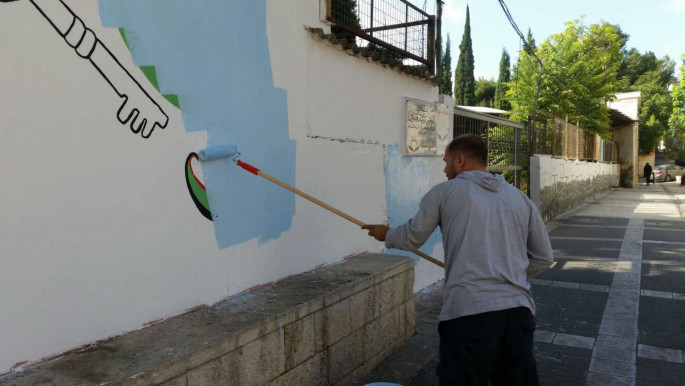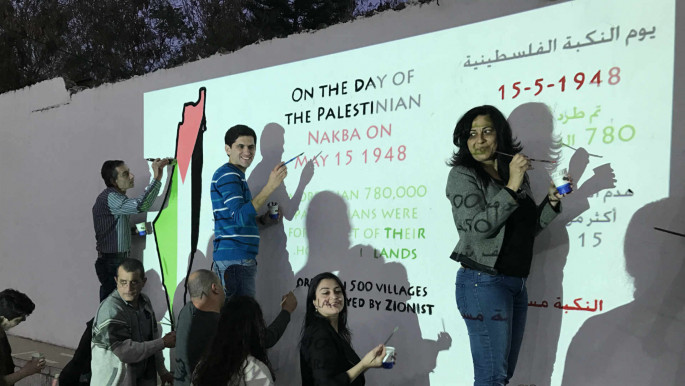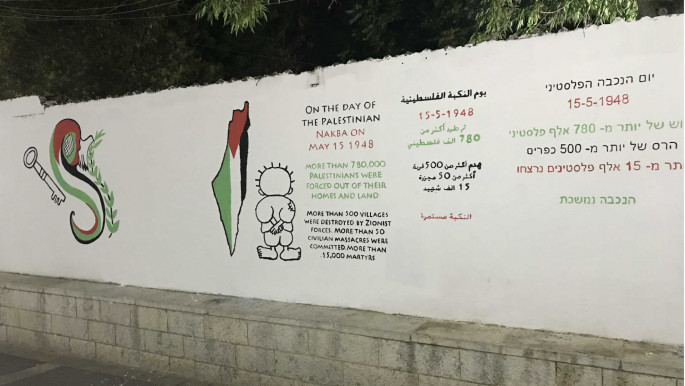Nazareth's mystery mural as an emblem of Palestinian resistance
Despite the level of security surrounding it, this is no priceless Old Master, or even a valuable Banksy stencil, but rather a humble mural painted by amateur volunteer artists from the local community. Its fiercest critics seemingly motivated by political rather than artistic differences.
First painted in 2014 by a youth group called Haq al-Shabibya, the mural commemorates the Nakba - the 1948 expulsion and exodus of Palestinians - one of history's largest forcible displacements.
When the artwork was, one morning in May 2016, discovered to have been painted over by persons unknown, community welfare organisation Sanabda' took on the task of restoring it.
Ten days later, a further night-time whitewashing of the memorial led to a repaint for a second time. In October 2016, cameras were installed in a bid to identify the culprits – but this too was mysteriously destroyed.
Later, in April 2017 the faceless critics returned and erased the mural once again, and once again Sanabda' returned with paint and brushes to restore the work. This scene was repeated in May and again on two occasions in August, when CCTV was installed and volunteer night-watchmen began working shifts.
 |
|
| The mural being painted over by a municipal worker [TNA] |
Each fresh repainting has become a community event and a show of celebratory defiance, attracting crowds of children and families, in a collective show of defiance – an example, perhaps, of the Palestinian ethic of Sumud, or steadfastness.
A projector beams the imagery onto the wall, allowing participants of any age and artistic ability to contribute by tracing over the projection in paint. The mural's eighth exhaustive restoration was completed on 6 September.
While the design has evolved a little over time, the theme has remained a commemoration of the Nakba. The iconic cartoon character Handala, the symbol of Palestinian hopes, stands alongside text in Arabic, English and Hebrew.
"On the day of the Palestinian Nakba on May 15 1948 – More than 780,000 Palestinians were forced out of their homes and lands – More than 500 villages were destroyed by Zionist forces – More than 50 civilian massacres were committed – More than 15,000 martyrs," the mural reads.
A map, painted with the Palestinian flag, unifies the West Bank, Gaza and modern-day Israel as one Palestinian territory, and a giant key symbolises Palestinian refugees' claim to return to their former homes.
Located in a prominent public place, near Nazareth's souk and on the state-sponsored 'Pilgrims Trail' tourist route, these are words and images bound to rile the Israeli state, which forbids teaching of the Nakba in schools and has banned its commemoration by any organisation in receipt of public funds.
 |
|
| Activists paint over a projection [TNA] |
Speculation over who was responsible for the repeated attacks on the mural stirred up accusations against the city authorities of collusion with the Israeli state, in a local political scene already febrile with allegations of corruption at the municipal level.
Suspicions of official involvement were fuelled by chronology, with many of the erasures preceding events at which the mural would bring embarrassment to the Mayor and the state, such as the May 2017 visit to the town by northern Israel's new police chief, or Israeli Channel 10's August live report from Nazareth on its political scandals.
The CCTV cameras eventually served their purpose, capturing video footage of the mural being erased in the dead of night by individuals alleged to be municipal employees.
Subsequently, the serial whitewashers revealed themselves in daylight, bringing the bizarre battle of wills into the open and revealing the militant art critics to be, as long alleged, the Nazareth municipality in partnership with the Israeli police.
The eighth, and most recent, whitewashing was preceded by a request from the Israeli police that the Greek Orthodox Council – the owners of the wall – remove the mural. When this was refused, municipal workers were sent, with a police escort, to enforce the request.
Sanabda's manager, Luai Asfour, believes the state's desire to suppress Palestinian memory and identity is the driving motivation behind attacks on the mural.
"They don't want the tourists from Israel and abroad to know about the Nakba," said Asfour.
"This street is visited by tens of tourists each day, if not more. The Nakba mural is about our heritage and about the history of a people. Whoever destroys it is erasing the history of our people, and seeks to prevent us from raising awareness and educating the young generations about our past.
 |
|
| The mural in its most recent version [TNA] |
"The ruling authority, acting through their middle men, think that by destroying it they can erase the Palestinian people's history and what happened to us when the state of Israel was founded."
The authorities have shown themselves willing to use more than just paint and brushes to make their point.
Sanabda' members, following the most recent whitewashing, were taken into custody and questioned, and were released on condition of proof the wall was not public property. None of this, however, has deterred Nazareth's collective of volunteer artists, and at the time of writing, the mural's eighth incarnation still graces the Pilgrims' Trail.
The artists do not expect their work to be left alone, and how this battle of wills might end is unclear, but Asfour is adamant that it will not end with surrender by Sanabda' and its supporters.
"There is great dissatisfaction in the community and among those who support us about the continued painting-over of the mural," Asfour said.
"People are determined to persist even if its story becomes like that of A'raqeeb, a village that has been destroyed and rebuilt for the hundredth time."



